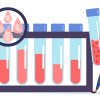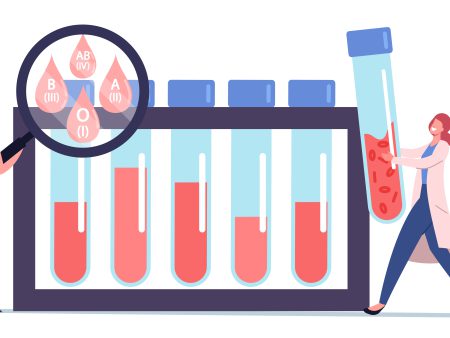
This article explores the many facets of genetic parentage, focusing on blood groups and their role in determining family ties. It discusses the potential of DNA in genealogy, as well as the tools offered by molecular biology to resolve questions relating to parentage or uncertain paternity. Finally, he looks at ethics and confidentiality in this exciting field of study.
Blood types
The study of blood groups is a crucial element in understanding human genetics and parentage. Four main categories are recognized: A, B, AB and O, based on the antigens present on the surface of red blood cells.
The genes that produce these antigens are passed on to us by our parents in a codominant Mendelian inheritance pattern. For example, a group A person may have received two A alleles (one from each parent), or an A allele from one parent and an O allele (which produces no antigen) from the other parent. The same logic applies to Group B.
The AB group is a combination of an A allele and a B allele from both parents. On the other hand, group O, which has no antigen on its red blood cells, derives either from the OO couple.
This genetic diversity makes it possible to reliably establish family links thanks to DNA tests based on the comparative analysis of individual genetic profiles in relation to blood groups. The combined use of genetic markers associated with blood groups offers significant precision in determining biological parentage between individuals.
Understanding parentage
The concept of genetic parentage
Genetic parentage is a key concept in biology and medicine, referring to the transmission of hereditary characteristics from one generation to the next. Genes, the fundamental units of heredity, are transmitted by parents to their offspring during the reproductive process. This encompasses not only apparent physical traits, but also less perceptible elements such as blood type or certain susceptibilities to specific diseases.
Parentage and family law
In family law, filiation defines a legal relationship between two individuals, where one is recognized as the legitimate descendant of the other. This connection can be established naturally by birth or artificially by adoption. Accurate identification of parentage can have significant consequences in various aspects of family law, including child custody, parental rights and even financial aspects such as inheritance.
DNA in genealogy
DNA genealogy has revolutionized the way we understand our ancestry. This technique is based on the examination of DNA, which carries our heredity and contains the genetic instructions essential to the development and functioning of living organisms.
The main benefit of this approach is its ability to establish precise family links without the need for arduous investigations or sometimes impossible-to-find historical documents.
- It can shed light on previously unknown or confirmed relationships.
- It can accurately define ethnic origins.
- It offers a genetic map of our ancestors across the globe.
- It is an effective tool for tracing specific maternal and paternal lines through mitochondrial and Y-DNA testing respectively.
It should be noted, however, that this science is not without limits. Results can be influenced by various factors such as contamination, spontaneous mutations or technical errors during the extraction and sequencing process.
The judicious use of DNA testing in genealogy can provide precise information about our family background and help build a more complete and accurate family tree.
Determining kinship
DNA paternity test
Determining paternal descent is of crucial importance in fields ranging from family law to anthropology. DNA paternity testing is used to establish a genetic link between an individual presumed to be the father and his presumed child. It’s based on the principle that each person inherits half their chromosomes from the father and the other half from the mother. Comparative examination of the genetic profiles of the presumed father and the child therefore makes it possible to confirm or deny this link.
DNA Maternity test
DNA maternity testing is less frequently used but may be necessary in specific cases such as international adoption cases or surrogacy issues. This test works on the same principle as that used to determine paternity: it examines the chromosome sequences transmitted by the alleged mother to those present in the child.
DNA fraternity test
DNA fraternity test aims to confirm whether two people share one or two parents in common. By analyzing specific genetic markers, we can establish whether these people are half-sisters (sharing either the same father or the same mother) or full sisters (having both parents in common). These tests are particularly useful for establishing family ties in immigration cases, or for resolving inheritance disputes.
Molecular biology
Molecular biology, fundamental to the identification of parentage, sheds light on blood groups and their consequences.
By examining the structure of DNA and its distinctive sequences, this discipline determines with great precision the genetic relationships between individuals. For example, the ABO blood group system is coded by a single gene with three alleles: A, B and O. As the O allele is recessive in relation to the other two, it is possible to establish certain information about parentage based on blood type.
However, caution must be exercised before drawing definitive conclusions. While this method can help to confirm or refute a presumed parent-child relationship, thanks to the principles of Mendelian heredity that govern such visible phenotypic traits as blood type, it simply represents one element among many.
More modern molecular techniques such as polymerase chain reaction (PCR) and DNA sequencing are currently used to obtain complete genetic profiles, enabling more in-depth and reliable analysis.
Molecular biology thus plays an essential role in our understanding of parentage, while remaining complementary to other existing methods.
Uncertain paternity
In the field of genetics, uncertain paternity is a complex issue. The blood group system can be used as a first approach to resolving these delicate situations. Everyone receives one allele from his father and another from his mother, which together define his blood group.
However, this method has its limits, as it does not always guarantee absolute certainty of paternal lineage. To achieve this, researchers are using more sophisticated DNA tests that examine several genetic indicators at the same time.
This technology offers far superior accuracy and makes a major contribution to clarifying ambiguous paternity cases.
The search for one’s origins
DNA testing for ethnic origin
In genetics, ancestry testing is a tool used to trace ancestral and geographical roots. It is based on the analysis of the individual’s genome and its comparison with those present in global databases. In this way, an assessment can be made of the percentage of inheritance from various geographical regions.
Population genetics
Population genetics offers a precise and measurable perspective on the relationships between people over time and space. It examines the distribution and variation of allele frequencies within a human group, under the simultaneous influence of several factors:
- Mutation: the primary origin of all genetic variability.
- Evolution: a process that causes a change in allelic frequencies.
- Genetic drift: random changes in allele frequencies over time.
- Migration flows: inter-population movements that have a direct impact on genome structure.
- Natural selection: favoring certain genes according to their contribution to survival or reproduction.
Historical human migration
The study of historical human migrations is based, among other things, on the indelible imprints that these movements have left in our DNA. By following these ancestral lines, it becomes possible not only to create a universal map of human movement, but also to understand how these migrations have shaped our contemporary genetic diversity.
Genome analyses reveal that most human groups are the result of a long series of migrations and integrations over the millennia.
Ethics and confidentiality
The importance of ethics and confidentiality in blood typing cannot be underestimated.
Every individual has the right to rigorous protection of his or her genetic data. Unauthorized or ill-intentioned use of blood group information can harm a person’s privacy and lead to a variety of ethical complications.
All specialists involved in this kind of investigation are bound by a strict code of ethics that ensures the anonymity and secrecy of the information they gather. This regulation is crucial to preserving an elevated level of scientific integrity while respecting the essential rights of every individual involved.












